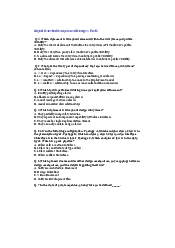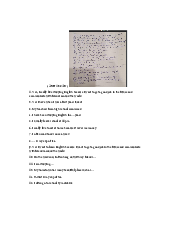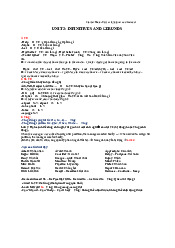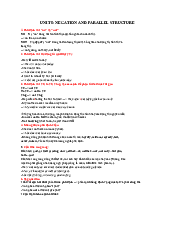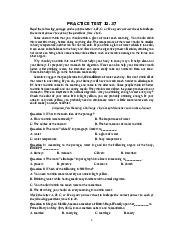








































Preview text:
READING PASSAGE 2
You should spend about 20 minutes onQuestions 15-27which are based on Reading Passage 2 below. Cosmetics in Ancient Past A
Since cosmetics and perfumes are still in wide use today, it is interesting to
compare the attitudes, customs and beliefs related to them in ancient times
to those of our own day and age. Cosmetics and perfumes have been
popular since the dawn of civilization; it is shown by the discovery of a great
deal of pertinent archaeological material, dating from the third millennium
BC. Mosaics, glass perfume flasks, stone vessels, ovens, cooking-pots, clay
jars, etc., some inscribed by the hand of the artisan. Evidence also appears
in the Bible and other classical writings, where it is written that spices and
perfumes were prestigious products known throughout the ancient world and
coveted by kings and princes. The written and pictorial descriptions, as well
as archaeological findings, all show how important body care and aesthetic
appearance were in the lives of the ancient people. The chain of evidence
spans many centuries, detailing the usage of cosmetics in various cultures
from the earliest period of recorded history. B
In antiquity, however, at least in the onset, cosmetics served in religious
ceremonies and for healing purposes. Cosmetics were also connected with
cultic worship and witchcraft: to appease the various gods, fragrant
ointments were applied to the statuary images and even to their attendants.
From this, in the course of time, developed the custom of personal use, to
enhance the beauty of the face and the body, and to conceal defects. C
Perfumes and fragrant spices were precious commodities in antiquity, very
much in demand, and at times even exceeded silver and gold in value.
Therefore they were luxury products, used mainly in the temples and in the
homes of the noble and wealthy. The Judean kings kept them in treasure
houses (2 Kings 20:13). And the Queen of Sheba brought to Solomon
“camels laden with spices, gold in great quantity and precious stones.” (1
Kings 10:2, 10). However, within time, the use of cosmetics became the
custom of that period. The use of cosmetics became widespread among the
lower classes as well as among the wealthy; in the same way, they washed
the body, so they used to care for the body with substances that softened
the skin and anoint it with fragrant oils and ointments. D
Facial treatment was highly developed and women devoted many hours to it.
They used to spread various scented creams on the face and to apply
makeup in vivid and contrasting colors. An Egyptian papyrus from the 16th
century BC contains detailed recipes to remove blemishes, wrinkles, and
other signs of age. Greek and Roman women would cover their faces in the
evening with a “beauty mask” to remove blemishes, which consisted mainly
of flour mixed with fragrant spices, leaving it on their face all night. The next
morning they would wash it off with asses’ milk. The very common creams
used by women in the ancient Far East, particularly important in the hot
climate and prevalent in that area of the globe, were made up of oils and
aromatic scents. Sometimes the oil in these creams was extracted from
olives, almonds, gourds, sesame, or from trees and plants; but, for those of
limited means, scented animal and fish fats were commonly used. E
Women in the ancient past commonly put colors around their eyes. Besides
beautification, its purpose was also medicinal as covering the sensitive skin
of the lids with colored ointments that prevented dryness and eye diseases:
the eye-paint repelled the little flies that transmitted eye inflammations.
Egyptian women colored the upper eyelid black and the lower one green and
painted the space between the upper lid and the eyebrow gray and blue. The
women of Mesopotamia favored yellows and reds. The use of kohl for
painting the eyes is mentioned three times in the Bible, always with
disapproval by the sages (2 Kings, 9:30; Jeremiah 4:30; Ezekiel 23:40). In
contrast, Job named one of his daughters “Keren Happukh”- “horn of eye paint” (Job 42:14) F
Great importance was attached to the care for hair in ancient times. Long
hair was always considered a symbol of beauty, and kings, nobles and
dignitaries grew their hair long and kept it well-groomed and cared for.
Women devoted much time to the style of the hair; while no cutting, they
would apply much care to it by arranging it skillfully in plaits and “building it
up” sometimes with the help of wigs. Egyptian women generally wore their
hair flowing down to their shoulders or even longer. In Mesopotamia, women
cherished long hair as a part of their beauty, and hair flowing down their
backs in a thick plait and tied with a ribbon is seen in art. Assyrian women
wore their hair shorter, braiding and binding it in a bun at the back. In
Ancient Israel, brides would wear their hair long on the wedding day as a
sign of their virginity. Ordinary people and slaves, however, usually wore
their hair short, mainly for hygienic reasons, since they could not afford to
invest in the kind of treatment that long hair required. G
From the Bible and Egyptian and Assyrian sources, as well as the words of
classical authors, it appears that the centers of the trade-in aromatic resins
and incense were located in the kingdoms of southern Arabia, and even as
far as India, where some of these precious aromatic plants were grown.
“Dealers from Sheba and Rammah dealt with you, offering the choicest
spices…” (Ezekiel 27:22). The Nabateans functioned as the important
middlemen in this trade; Palestine also served as a very important
component, as the trade routes crisscrossed the country. It is known that the
Egyptian Queen Hatsheput (15th century BC) sent a royal expedition to the
Land of Punt (Somalia) in order to bring back myrrh seedlings to plant in her
temple. In Assyrian records of tribute and spoils of war, perfumes and resins
are mentioned; the text from the time of Tukulti-Ninurta II (890-884 BC)
refers to balls of myrrh as a part of the tribute brought to the Assyrian king
by the Aramaean kings. The trade-in spices and perfumes are also
mentioned in the Bible as written in Genesis (37:25-26), “Camels carrying
gum tragacanth and balm and myrrh”. Questions 15-21
Reading Passage 2 has 7 paragraphsA-G
Which paragraph contains the following information?
Write your answers in boxes 15-21on your answer sheet.
15recipes to conceal facial defects caused by aging
16perfumes were presented to conquerors in war
17long hair of girls had special meanings in marriage
18evidence exists in abundance showing cosmetics use in ancient times
19protecting eyes from fly-transmitted diseases
20from witchcraft to beautification
21more expensive than gold Question 22-27
Do the following statements agree with the information given in Reading Passage 2?
In boxes22-27on your answer sheet, write
TRUE if the statement is true
FALSE if the statement is false
NOT GIVEN if the information is not given in the passage
22The written record for cosmetics and perfumes dates back to the third millennium BC.
23Since perfumes and spices were luxury products, their use was
exclusive to the noble and the wealthy.
24In the ancient Far East, fish fats were used as a cream by a woman from poor households.
25The teachings in the Bible were repeatedly against the use of kohl for painting the eyes.
26Long hair as a symbol of beauty was worn solely by women of ancient cultures
27The Egyptian Queen Hatsheput sent a royal expedition to Punt to
establish a trade route for myrrh READING PASSAGE 3
You should spend about 20 minutes onQuestions 28-40which are based on Reading Passage 3 below.
The Secrets of Persuasion A
Our mother may have told you the secret to getting what you ask for was to
say please. The reality is rather more surprising. Adam Dudding talks to a
psychologist who has made a life’s work from the science of persuasion.
Some scientists peer at things through high-powered microscopes. Others
goad rats through mazes or mix bubbling fluids in glass beakers. Robert
Cialdini, for his part, does curious things with towels and believes that by
doing so he is discovering important insights into how society works. B
Cialdini’s towel experiments (more of them later), are part of his research
into how we persuade others to say yes. He wants to know why some people
have a knack for bending the will of others, be it a telephone cold-caller
talking to you about timeshares, or a parent whose children are compliant
even without threats of extreme violence. While he’s anxious not to be seen
as the man who’s written the bible for snake-oil salesmen, for decades the
Arizona State University social psychology professor has been creating
systems for the principles and methods of persuasion and writing bestsellers
about them. Some people seem to be born with the skills; Cialdini’s claim is
that by applying a little science, even those of us who aren’t should be able
to get our own way more often. “All my life I’ve been an easy mark for the
blandishment of salespeople and fundraisers and I’d always wondered why
they could get me to buy things I didn’t want and give to causes I hadn’t
heard of,” says Cialdini on the phone from London, where his is plugging his latest book. C
He found that laboratory experiments on the psychology of persuasion were
telling only part of the story, so he began to research influence in the real
world, enrolling in sales-training programmes: “I learnt how to sell
automobiles from a lot, how to sell insurance from an office, how to sell
encyclopedias door to door.” He concluded there were six general “principles
of influence” and has since put them to the test under slightly more scientific
conditions. Most recently, that has meant messing about with towels. Many
hotels leave a little card in each bathroom asking guests to reuse towels and
thus conserve water and electricity and reduce pollution. Cialdini and his
colleagues wanted to test the relative effectiveness of different words on
those cards. Would guests be motivated to co-operate simply because it
would help save the planet, or were other factors more compelling? To test
this, the researchers changed the card’s message from an environmental
one to the simple (and truthful) statement that the majority of guests at the
hotel had reused their towel at least once. Guests given this message were
26% more likely to reuse their towels than those given the old message. In
Cialdini’s book“Yes! 50 Secrets from the Science of Persuasion”,co-
written with another social scientist and a business consultant, he explains
that guests were responding to the persuasive force of “social proof”, the
idea that our decisions are strongly influenced by what we believe other people like us are doing. D
So much for towels. Cialdini has also learnt a lot from confectionery. Yes!
Cites the work of New Jersey behavioural scientist David Strohmetz, who
wanted to see how restaurant patrons would respond to ridiculously small
favour from their food server, in the form of after-dinner chocolate for each
diner. The secret, it seems, is in how you give the chocolate. When the
chocolates arrived in a heap with the bill, tips went up a miserly 3%
compared to when no chocolate was given. But when the chocolates were
dropped individually in front of each diner, tips went up 14%. The scientific
breakthrough, though, came when the waitress gave each diner one
chocolate, headed away from the table then doubled back to give them one
more each as if such generosity had only just occurred to her. Tips went up
23%. This is “reciprocity” in action: we want to return favours done to us,
often without bothering to calculate the relative value of what is being received and given. E
Geeling Ng, operations manager at Auckland’s Soul Bar, says she’s never
heard of Kiwi waiting staff using such a cynical trick, not least because New
Zealand tipping culture is so different from that of the US: “If you did that in
New Zealand, as diners were leaving they’d say ‘can we have some more?” ‘
But she certainly understands the general principle of reciprocity. The way to
a diner’s heart is “to give them something they’re not expecting in the way
of service. It might be something as small as leaving a mint on their plate, or
it might be remembering that last time they were in they wanted their water
with no ice and no lemon. “In America, it would translate into an instant tip.
In New Zealand, it translates into a huge smile and thanks to you.” And no doubt, return visits.
THE FIVE PRINCIPLES OF PERSUASION F
Reciprocity:People want to give back to those who have given to them.
The trick here is to get in first. That’s why charities put a crummy pen inside
a mailout, and why smiling women in supermarkets hand out dollops of free
food. Scarcity: People want more of things they can have less of. Advertisers
ruthlessly exploit scarcity (“limit four per customer”, “sale must end soon”),
and Cialdini suggests parents do too: “Kids want things that are less
available, so say ‘this is an unusual opportunity; you can only have this for a certain time’.” G
Authority:We trust people who know what they’re talking about. So inform
people honestly of your credentials before you set out to influence them.
“You’d be surprised how many people fail to do that,” says Cialdini. “They
feel it’s impolite to talk about their expertise.” In one study, therapists whose
patients wouldn’t do their exercises were advised to display their
qualification certificates prominently. They did and experienced an
immediate leap in patient compliance. H
Commitment/consistency:We want to act in a way that is consistent with
the commitments we have already made. Exploit this to get a higher sign-up
rate when soliciting charitable donations. First, ask workmates if they think
they will sponsor you on your egg-and-spoon marathon. Later, return with
the sponsorship form to those who said yes and remind them of their earlier commitment. I
Linking:We say yes more often to people we like. Obvious enough, but
reasons for “linking” can be weird. In one study, people were sent survey
forms and asked to return them to a named researcher. When the researcher
gave a fake name resembling that of the subject (eg, Cynthia Johnson is sent
a survey by “Cindy Johansen”), surveys were twice as likely to be completed.
We favour people who resemble us, even if the resemblance is as minor as the sound of their name. J
Social proof:We decide what to do by looking around to see what others
just like us are doing. Useful for parents, says Cialdini. “Find groups of
children who are behaving in a way that you would like your child to,
because the child looks to the side, rather than at you.” More perniciously,
social proof is the force underpinning the competitive materialism of
“keeping up with the Joneses” Questions 28-31
Choose the correct letterA,B,Cor . D
28The main purpose ofCialdini’s research of writing is to
A explain the reason way researcher should investigate in person
B explore the secret that why some people become the famous salesperson
C help people to sale products
D prove maybe there is a science in the psychology of persuasion
29Which of the statement is CORRECT according toCialdini’s research methodology
A he checked data in a lot of latest books
B he conducted this experiment in the laboratory
C he interviewed and contract with many salespeople
D he made lot phone calls collecting what he wants to know
30Which of the following is CORRECT according to towel experiment in the passage?
A Different hotel guests act in a different response
B Most guests act by the idea of environment preservation
C more customers tend to cooperate as the message requires than simply act environmentally
D people tend to follow the hotel’s original message more
31Which of the following is CORRECT according to the candy shop experiment in the passage?
A Presenting way affects diner’s tips
B Regular customer gives tips more than irregulars
C People give tips only when offered chocolate
D Chocolate with bill got higher tips Questions 32-35
Do the following statements agree with the information given in Reading Passage 3?
In boxes32-35on your answer sheet, write
TRUE if the statement is true
FALSE if the statement is false
NOTGIVEN if the information is not given in the passage
32Robert Cialdini experienced “principles of influence” himself in realistic life.
33Principle of persuasion has different types in different countries.
34In New Zealand, people tend to give tips to attendants after being served chocolate.
35Elder generation of New Zealand is easily attracted by extra service of
restaurants by the principle of reciprocity. Questions 36-40
Use the information in the passage to match the category (listed A-E) with correct description below.
Write the appropriate letters
A-E in boxes 36-40on answer sheet.
NBYou may use any letter more than once.
A Reciprocity of scarcity B Authority C previous comment D Linking
36Some expert may reveal qualification in front of clients.
37Parents tend to say something that other kids are doing the same.
38Advertisers ruthlessly exploit the limitation of chances.
39Use a familiar name in a survey.
40Ask colleagues to offer a helping hand READING PASSAGE 1
You should spend about 20 minutes onQuestions1-
13which arebased on Reading Passage 1 below. Food for thought 2 A
There are not enough classrooms at the Msekeni
primary school, so half the lessons take place in
the shade of yellow-blossomed acacia trees. Given
this shortage, it might seem odd that one of the
school’s purpose-built classrooms has been
emptied of pupils and turned into a storeroom for
sacks of grain. But it makes sense. Food matters more than shelter. B
Msekeni is in one of the poorer parts of Malawi, a
landlocked southern African country of exceptional
beauty and great poverty. No war lays waste
Malawi, nor is the land unusually crowed or
infertile, but Malawians still have trouble finding
enough to eat. Half of the children under five are
underfed to the point of stunting. Hunger blights
most aspects of Malawian life, so the country is as
good a place as any to investigate how nutrition
affects development, and vice versa. C
The headmaster at Msekeni, Bernard Kumanda,
has strong views on the subject. He thinks food is a
priceless teaching aid. Since 1999, his pupils have
received free school lunches. Donors such as the
World Food Programme (WFP) provide the food:
those sacks of grain (mostly mixed maize and soya
bean flour, enriched with vitamin A) in that
converted classroom. Local volunteers do the
cooking – turning the dry ingredients into a bland
but nutritious slop and spooning it out on to plastic
plates. The children line up in large crowds,
cheerfully singing a song called “We are getting porridge”. D
When the school’s feeding programme was
introduced, enrolment at Msekeni doubled. Some
of the new pupils had switched from nearby
schools that did not give out free porridge, but
most were children whose families had previously
kept them at home to work. These families were so
poor that the long-term benefits of education
seemed unattractive when setting against the
short-term gain of sending children out to gather
firewood or help in the fields. One plate of porridge
a day completely altered the calculation. A child
fed at school will not howl so plaintively for food at
home. Girls, who are more likely than boys to be
kept out of school, are given extra snacks to take home. E
When a school takes in a horde of extra students
from the poorest homes, you would expect
standards to drop. Anywhere in the world, poor
kids tend to perform worse than their better-off
classmates. When the influx of new pupils is not
accompanied by an increase in the number of
teachers, as was the case at Msekeni, you would
expect standards to fall even further. But they
have not. Pass rates at Msekeni improved
dramatically, from 30% to 85%. Although this was
an exceptional example, the nationwide results of
school feeding programmes were still pretty good.
On average, after a Malawian school started
handing out free food it attracted 38% more girls
and 24% more boys. The pass rate for boys stayed
about the same, while for girls it improved by 9.5%. F
Better nutrition makes for brighter children. Most
immediately, well-fed children find it easier to
concentrate. It is hard to focus the mind on long
division when your stomach is screaming for food.
Mr Kumanda says that it used to be easy to spot
the kids who were really undernourished. “They
were the ones who stared into space and didn’t
respond when you asked the question,” he says.
More crucially, though, more and better food helps
brains grow and develop. Like any other organ in
the body, the brain needs nutrition and exercise.
But if it is starved of the necessary calories,
proteins and micronutrients, it is stunted, perhaps
not as severely as a muscle would be, but stunted
nonetheless. That is why feeding children at
schools work so well. And the fact that the effect of
